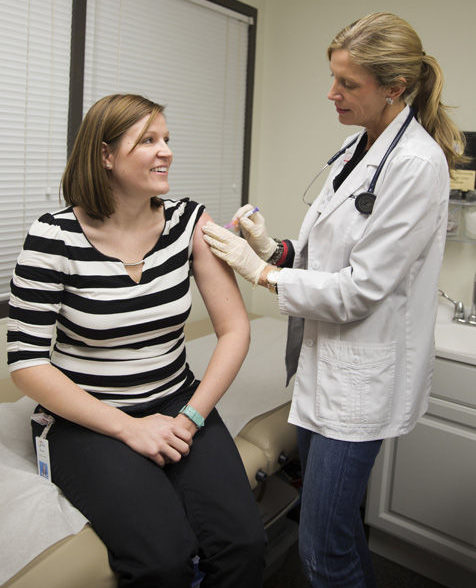
You’ve decided to get a flu shot. Maybe it’s the first time; maybe it’s something you’ve been diligent about for years, as you are aware of the very compelling reasons to do so. You think you know what to expect – perhaps some discomfort at the injection site for a day or two, perhaps a low-grade fever.
It never occurs to you that you will be in terrible pain for weeks afterward, unable to sleep, with no range of motion in the injected arm. And that the injury can only be fixed by a difficult and painful surgery, followed by weeks of physical therapy.
That’s the experience of Sue Keller, a seasonal Vero Beach resident. Shortly before Thanksgiving 2014, she went to an urgent care clinic in her home state of Connecticut for a flu shot, as was her annual practice. The shot was administered high on her left arm by a board-certified medical doctor. Too high, Sue thought at the time, though she did not say anything to the doctor. She dismissed the soreness she experienced later that day as normal, just part of the process.
After a week of continued pain, Sue visited her own primary care physician, and was ultimately referred to an orthopedic surgeon, who thought she had bursitis or tendonitis. Sue says, “My pain was not being connected to the flu shot; the doctors thought it was a coincidence, although I thought that maybe the needle had hit a nerve.” Sue received a shot of cortisone, which helped a little, but two weeks later the pain was so bad that she says, “I felt like I wanted to cut my arm off.”
Sue had an MRI which showed a small tear in her rotator cuff at the site of the injection, clearly the source of her pain. The needle had gone right into her tendon. The only effective treatment would be surgery, followed by physical therapy.
By this time, Sue’s husband, Brian, had been doing research. He learned that when something goes wrong after receiving a government-recommended vaccination (influenza being just one example), you can’t obtain financial compensation for medical care, pain, or suffering by suing the vaccine manufacturer or the health care professional who administered the shot – Congress and the Supreme Court have banned vaccine product liability and injury malpractice lawsuits.
Instead, injury claims can be made via “petitioning” the Vaccine Injury Compensation Program (VICP), which is administered by the federal government. Funding for the VICP comes from a tax of 75 cents per vaccine dose, collected from vaccine manufactures by the Department of the Treasury.
Guidelines are both specific and stringent; for instance, to be eligible to file a claim, the effects of the person’s injury must have:
• Lasted for more than 6 months after the vaccine was given OR
• Resulted in a hospital stay and surgery OR
• Resulted in death
As may be expected with any government-run program, the petitioning process is not particularly easy, and even comes with a $400 filing fee. And the resolution process is not speedy; a November 2014 study by the U.S. Government Accountability Office (GAO) found that only 11 percent of the claims were adjudicated in 1 year or less, and 5 percent took more than 5 years.
While knowledge of the VICP’s existence is a good thing – it is not one of the more widely-known government programs – it’s much more important to be aware of best practices before you get your next vaccination.
This is from a 2013 article in the Journal of the American Pharmacists Association: “Erroneous administration of intramuscular vaccines, particularly above the deltoid muscle, can result in serious shoulder injuries and diminished vaccine efficacy.”
The deltoid is the muscle forming the rounded contour of the shoulder; the article is quite clear that vaccines should be injected into the thickest, most central portion of the deltoid muscle to prevent serious shoulder injuries.
According to Tanya Singler, a Nurse Practitioner with Vero Beach’s Visiting Nurse Association (VNA), injecting into the upper third of the muscle should be avoided; she says “I inject vaccinations into the medial [middle] part of the deltoid muscle. Patients should be sure to expose their entire deltoid to whoever is giving the injection to avoid injections being given too high.”
Illness or injury from vaccines is rare, and Singler does not want stories such as Sue’s to discourage people from receiving the flu vaccine, because the flu can and does kill. The CDC says there are several factors that make it difficult to accurately determine the number influenza-associated deaths, but it’s safe to say thousands of people in the United States suffer flu-associated deaths each year. And even an imperfect flu vaccine protects against some strains.
In January, Sue had surgery to repair the tear in her rotator cuff. She is still in pain. “It was a terrible surgery,” she says, “The only way I could sleep for the first three weeks was in a recliner.” Her daughter, who is 40, fainted at the sight of seeing her mother in so much pain.
Sue is now in the midst of physical therapy—3 times a week for 3 months. All other times, she wears a sling to keep her arm immobilized. She can’t drive, and the sports she loves – golf, tennis, and paddle tennis – are out of the question. There is one positive about this whole ordeal. She says, “I really wanted to tell my story so that others don’t have to go through this.”
The VNA is a community-based non-profit organization offering medical, social, and support services to Indian River and surrounding counties. It is located at 1110 35th Lane in Vero Beach; the toll-free number is 800-749-5760.



